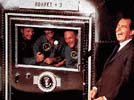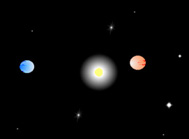




Protecting Earth from Space
When Neil Armstrong, Edwin "Buzz" Aldrin and Michael Collins returned to Earth after mankind's first venture to another world, scientists were concerned that the astronauts may have become contaminated with space microbes. After all, we did not know for certain whether or not dangerous microbes could survive in the vacuum of space, or in the soil of the Moon. The Apollo 11 astronauts were therefore sealed inside an air-tight diving decompression chamber for several days, to see if they might develop symptoms of illness. They were quarantined. President Richard Nixon had to communicate with the triumphant explorers through an intercom and a window.
The astronauts did not develop any strange illnesses and all the precautions seemed to have been for no purpose. No space-bugs - new bacteria or virus strains - were found.
 |
While it appears that no alien life returned to Earth with the first Apollo landing mission, it is possible that Earth-life was released into space, if not onto the Moon itself. The Apollo spacecraft were equipped with toilets that released un-processed urine into space. Urine can contain micro-organisms and so it is likely that human bacteria have been released in the space environment between Earth and the Moon. Will such bacteria survive? Unlikely. The vacuum, the low temperatures and especially the high radiation level (in particular in the UV wave-bands) should have killed everything. But maybe not...
(ABOVE) President Richard Nixon meets the crew of Apollo 11 on their return from the Moon. © NASA, 1969
When the Apollo 12 astronauts visited the Moon they landed near Surveyor 3, a robot probe that had landed on the Moon several years before. They examined Surveyor to see how it had survived in the presence of vacuum, high and low temperatures, and intense radiation from both the Sun and interstellar cosmic radiation.
In order to allow experts to carry out examinations in controlled laboratory conditions, the astronauts removed the video camera from Surveyor, sealed it in a sterile bag and brought it back to Earth.
When
the camera was examined it was found to be the home of a colony of bacteria,
Streptococcus mitis. However these
were not space monsters, but had come from Earth. They were thought
to be the result of inadequate cleaning techniques, which had failed to
sterilize the camera before it was put on the spacecraft and sent to the
Moon. However, there is also the possibility that the camera was
accidentally contaminated after
returning to Earth. If the bacteria had indeed survived
- not only the space travel, but space itself - their ordeal included
the vacuum of space, 3 years radiation exposure, temperatures as low as
20 K (36F above absolute zero), and no nutrient, water or other energy.
Something between 50 and 100 organisms appear to have remained viable.

(above) Surveyor 3 is examined by the crew of Apollo
12.
© NASA, 1970
0
Whether
or not the microbes did travel to the Moon, the lesson is clear.
By not taking adequate precautions we could accidentally release microbes
into space.
Bringing Home the Aliens
 Russia's
Luna 16 was the first robot spacecraft to return a soil sample from another
world, in this case the Moon. © RSA
Russia's
Luna 16 was the first robot spacecraft to return a soil sample from another
world, in this case the Moon. © RSA
Unless we are extremely careful, we may unwittingly bring unwanted and potentially dangerous life forms back to Earth, when we visit other planets and moons in the Solar System. Science fiction thrives on such stories and we might think that the reality of such possibilities is as fictional as the the stories. The likelihood of mankind encountering aggressive, huge, man-eating aliens is so absurdly unlikely we can dismiss the possibility out of hand, but what about microbes? We know that micro-organisms can survive in adverse conditions, including those found in space, possibly for prolonged periods. Long enough to hitch a ride on a spacecraft returning to Earth from an interplanetary mission. We also know that many bodies in the Solar System probably offer the right conditions for life to survive, if not flourish.
If alien microbes exist, it may be possible for them to to be brought back to Earth in soil and rock samples. Additionally, they may be able to "infect" a spacecraft in the dust that will inevitably be blown over the spacecraft during landing and from the wind in the atmosphere - assuming one is present.
Having established the possibility, what could be the consequences of returning alien microbes to Earth? Obviously, the consequences are unknown at present. On one hand the microbes may be harmless and benign and do nothing - not even react with the Earth environment. On the other, they could be highly infectious, causing illnesses in mankind, or worse, they could do irreparable damage to the Earth environment.
It is obvious that space scientists must prepare for the worst and assume that any spacecraft returning to Earth, with samples of anything from a distant planet or moon, will be contaminated with dangerous biological entities, both externally and within any samples it carries. NASA understands this well and has taken a lead both in preparing for the isolation of extra-terrestrial samples and in getting international acceptance of the standards and methods that will apply. Microbiologists generally agree with this approach now, but one suspects that they are driven more by the legal implications of their "getting it wrong" than by their belief that anything dangerous lurks on Mars or elsewhere.
While we can sterilize the spacecraft by various means, we do not want to do that with soil samples. They would therefore be returned to a specially-built containment facility, of the type used for research on virulent pathogens such as ebola virus. Here, the soil samples would be isolated from the world and examined with extreme caution. Unlike the lunar rock samples, which were passed to laboratories around the world, samples from other planets, moons, asteroids and comets will be kept in the one, well-protected facility for examination.
Plans for a Mars Soil Return Mission in 2003 and 2005, and cometary material return missions, are already in hand. The NASA Mars mission will collect about half a kilogram (just over a pound) of soil from the Martian surface. It will be packed in a triple layered container and sealed. It will be returned to Earth and only opened once it is in sealed glove boxes inside a Class 3 Biohazard containment facility. It will be treated almost at the same level as a virulent pathogen, such as ebola.
The packaging will be opened in stages. In the first glove box the outside package will be removed, and the package will be moved to a second box. Here the Martian atmospheric gases will be released and collected for examination. Finally the soil itself will be transferred to the last glove box, where it can be tested and examined.
While
soil samples are wanted by researchers, and are isolated in known places
within a returning spacecraft, external dust attached to the exterior
might not even be visible. A returning spacecraft may carry unwanted
passengers back to Earth
on its exterior. This must not happen, and some sort of en
route sterilization must take place.
Colonizing the Galaxy

When we visit other planets and moons with manned or un-manned missions, we must take great care that we do not take unwelcome passengers in the form of microbes, with us. As we have seen, if you have explored other parts of the Web site, micro-organisms, particularly archaea and bacteria can be extremely resilient in conditions that we would find unacceptable. They could easily hitch a ride on an interplanetary space vehicle.
They can endure high temperatures, at least as high as 170 C (338 F), low temperatures, radiation, vacuum, extreme pressures, acid, alkali, salts and other adverse chemical conditions, such as may be found in space and on other planets in the Solar System. Unless we sterilize spacecraft and isolate humans and human activity from the places we visit, we may contaminate them with our microbes, which may find a way to flourish in their new environment.
But why should this matter?
Firstly, we may introduce our vicious life to a fragile and precious world, where life forms new to us exist. We would want to study these in a pristine condition, uncontaminated with Earth material of any sort - biological or otherwise. Earth microbes may kill alien life forms, or crossbreed with them. This would effectively destroy any possibility of reliable research results, and we would throw away an unprecedented scientific opportunity which may answer some of mankind's most fundamental questions about his origin.
There are ethical questions to address, as well. For an introduction to the ethical considerations click here.
Go
to
Home
| Space Station
| Mars | Rainforest
© 1999 Satellite Events Enterprises Inc.